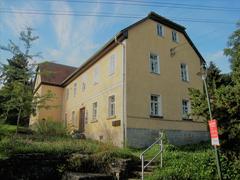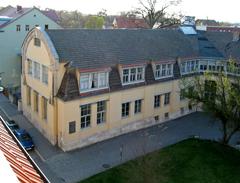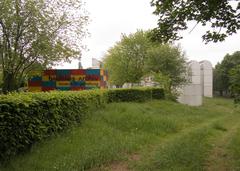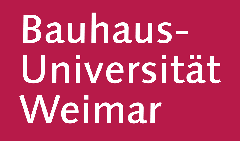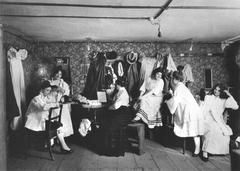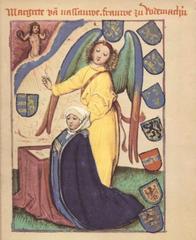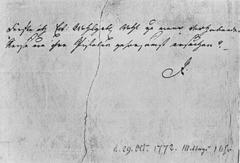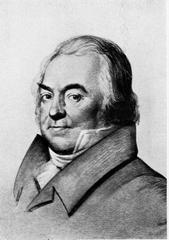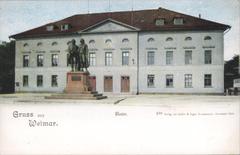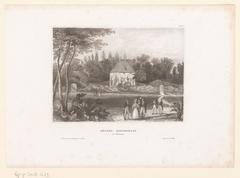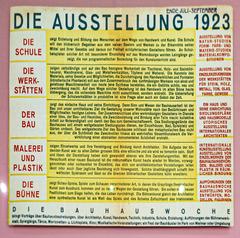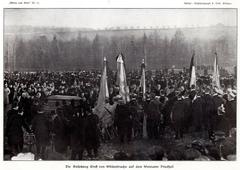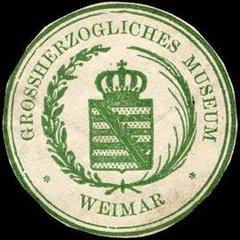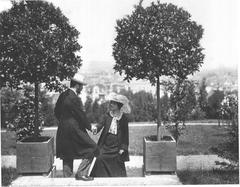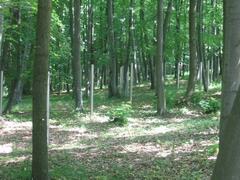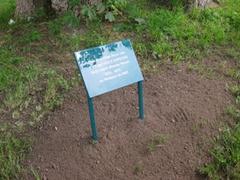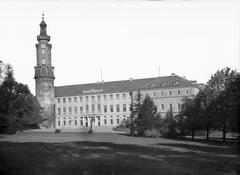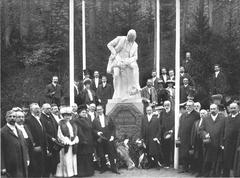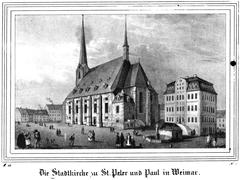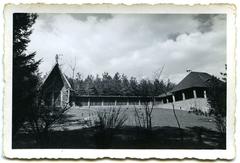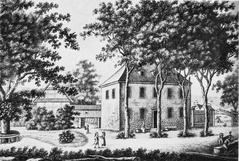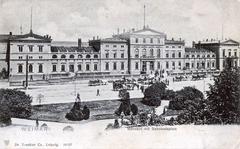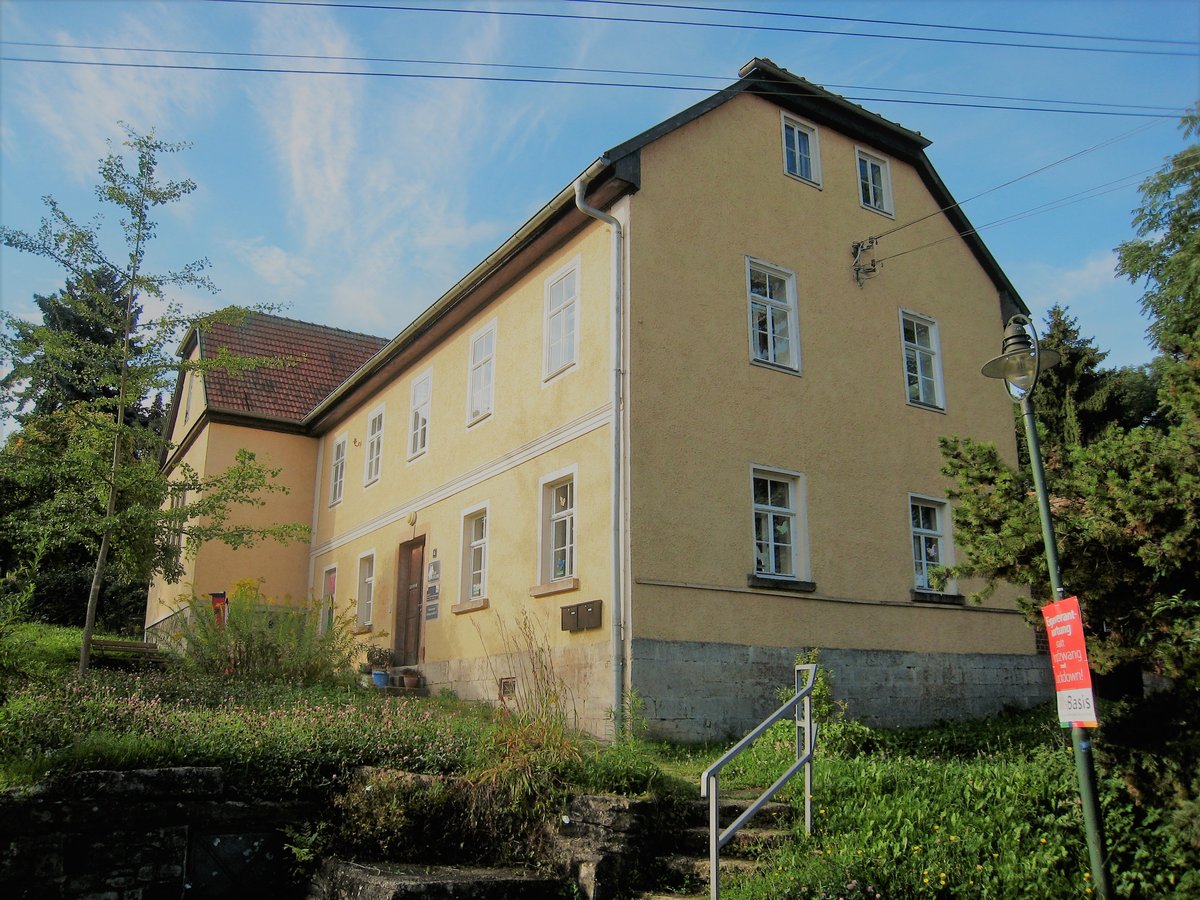
Old School Alte Schule Weimar: Visiting Hours, Tickets, and Comprehensive Visitor Guide
Date: 14/06/2025
Introduction to the Old School (Alte Schule) in Weimar
Located at the cultural core of Weimar, Germany, the Old School (Alte Schule) is a site of profound historical and architectural importance. Founded in 1860 as the Großherzogliche Kunstschule (Grand Ducal Art School), it became a catalyst for Weimar’s artistic revival in the wake of the city’s classical golden age. The building’s design, shaped between 1905 and 1911 by Belgian architect Henry van de Velde, is a hallmark of Art Nouveau, blending ornamental elegance with functional clarity—a precursor to the Bauhaus movement that would revolutionize 20th-century art and design. The Old School’s influence echoes globally, not least because it fostered the environment in which the Bauhaus was born under Walter Gropius in 1919. Today, the site’s UNESCO World Heritage status, awarded in 1996, cements its place in the narrative of Classical Modernism and underscores its enduring legacy in design, education, and architecture.
Centrally situated among Weimar’s iconic landmarks—such as Goethe’s House, the Duchess Anna Amalia Library, and the Bauhaus Museum—the Old School is an essential stop for anyone seeking to understand the city’s layered cultural heritage. This guide offers detailed insights into the Old School’s history, architectural significance, practical visiting information (including hours, ticketing, and accessibility), and curated tips for an enriching experience. Whether you are a design enthusiast, history lover, or curious traveler, this guide ensures you make the most of your visit to one of Germany’s—and the world’s—most influential sites (uni-weimar.de; whc.unesco.org; klassik-stiftung.de).
Table of Contents
- Introduction
- Historical Foundations and Architectural Evolution
- Bauhaus Era: Revolutionizing Art and Design
- The Old School During the Nazi Era
- UNESCO World Heritage Status and Cultural Impact
- Visiting the Old School: Practical Information
- Old School in Weimar’s Cultural Heritage
- Frequently Asked Questions (FAQ)
- Visuals and Media Suggestions
- Internal and External Links
- Call to Action
- References and Further Reading
Historical Foundations and Architectural Evolution
Origins and Early Development
The Old School’s foundation as the “Großherzogliche Kunstschule” in 1860 was a deliberate effort by the Grand Duchy of Saxe-Weimar-Eisenach to reestablish Weimar as a center for the arts after its classical era. The institution rapidly gained a reputation for excellence, drawing students and notable artists from across Germany and Europe, including Max Liebermann and Max Beckmann (uni-weimar.de).
Architectural Significance
Henry van de Velde’s architectural vision for Weimar was realized between 1905 and 1911 through a series of buildings for the Art and Applied Art Schools. His approach, rooted in Art Nouveau, emphasized the unity of art, craft, and practical function. The resulting structures, now integral to the Bauhaus-Universität Weimar, are distinguished by their abundant natural light, uncluttered lines, and restrained ornamentation—a conscious break from 19th-century historicism that paved the way for modernist design (whc.unesco.org).
Bauhaus Era: Revolutionizing Art and Design
Founding of the Bauhaus
In 1919, Walter Gropius merged the College of Fine Arts and the Vocational Arts School, founding the Staatliches Bauhaus Weimar. The Bauhaus sought to dissolve barriers between artistic disciplines, advocating for an integrated curriculum that combined hands-on workshops with theoretical instruction. Renowned avant-garde figures such as Paul Klee, Wassily Kandinsky, and László Moholy-Nagy were among its faculty, turning the school into a crucible for creative innovation (regiopia.com).
Socio-Political Context
The Bauhaus flourished in the atmosphere of reform during the Weimar Republic, embracing ideals of democracy and accessibility. However, mounting political pressure and conservative opposition led to funding cuts in 1924, prompting the school to move to Dessau and continue its legacy under a new name (germansights.com).
The Old School During the Nazi Era
Ideological Transformation
The Nazi regime brought a dramatic shift to the Old School’s direction. Under the leadership of Paul Schultze-Naumburg, the school rejected the modernist legacy of the Bauhaus and adopted a nationalist, ideologically driven curriculum, removing progressive faculty and reorienting its educational mission (uni-weimar.de).
Architectural Legacy and Preservation
Despite these upheavals, the Old School’s architectural ensemble—including the iconic Haus am Horn—survived wartime and postwar threats. Today, these buildings are protected under the Thuringian Protection of Historic Monuments Act, ensuring their preservation for future generations (whc.unesco.org).
UNESCO World Heritage Status and Cultural Impact
Recognition and Protection
In 1996, UNESCO recognized the significance of the Bauhaus and its associated sites in Weimar, Dessau, and Bernau by inscribing them on the World Heritage List. In Weimar, this includes the former Art School, the School of Applied Arts, and the Haus am Horn, emblematic of pioneering modernist ideals (whc.unesco.org).
Lasting Influence
The Bauhaus’s emphasis on functional design, interdisciplinary collaboration, and social responsibility continues to inspire architecture and design worldwide. The Old School’s buildings remain active parts of Bauhaus-Universität Weimar, nurturing creativity and innovation in the present day (uni-weimar.de).
Visiting the Old School: Practical Information
Opening Hours and Best Times to Visit
The Old School and its associated buildings are generally open Monday to Friday, 9:00 AM–5:00 PM. Some spaces are accessible on weekends during special exhibitions or events. For a quieter experience, visit early weekdays.
Ticket Information
Entry to exhibitions and guided tours typically ranges from €8–€12 for adults, with concessions available. Purchase tickets online through the Bauhaus-Universität Weimar website or at the ticket desk.
Accessibility
The site offers wheelchair access, with ramps and elevators in key areas. Visitors with specific needs are encouraged to contact the visitor center in advance to ensure seamless access.
Guided Tours and Special Events
Guided tours in English and German provide deep dives into the Old School’s history and architecture. Special programs, workshops, and temporary exhibitions are frequently scheduled; consult the official website for current offerings.
Travel Tips and Nearby Attractions
The Old School’s central location makes it easy to combine your visit with other major sites, such as Goethe’s House, Schiller Museum, and the Bauhaus Museum. Don’t miss photographing the distinctive Haus am Horn and the Bauhaus Main Building’s elegant façade.
Old School in Weimar’s Cultural Heritage
Integration with Intellectual Life
Weimar’s legacy is built on the achievements of Goethe, Schiller, and other intellectual giants. The Old School adds a modernist dimension to this tradition, particularly through its role in the Bauhaus movement, which transformed not only local culture but also global design thinking (germansights.com; discoverwalks.com).
Visitor Experience
Interactive exhibitions and guided tours bring to life the radical ideas and creative energy that once animated the Old School. For those unable to visit in person, virtual tours and digital resources are available on the Bauhaus-Universität Weimar website.
Frequently Asked Questions (FAQ)
What are the Old School Weimar’s visiting hours?
Monday to Friday, 9:00 AM–5:00 PM; limited hours on weekends during special events.
How do I buy tickets?
Purchase online through the official Bauhaus-Universität Weimar website or at the site.
Is the Old School wheelchair accessible?
Yes, with ramps and elevators to key areas.
Are guided tours available?
Yes, in English and German. Check the website for current schedules.
What attractions are nearby?
Goethe’s House, Schiller Museum, Weimar City Palace, and Bauhaus Museum are all within walking distance.
Visuals and Media Suggestions
- Include high-resolution images of the Old School’s exterior, Bauhaus Main Building, and Haus am Horn.
- Suggested alt texts: “Old School Weimar historic building façade,” “Bauhaus Weimar interior with natural light,” “Haus am Horn model house Weimar.”
- Consider linking to virtual tours and interactive maps from the Bauhaus-Universität Weimar website.
Internal and External Links
Internal: Link to related articles on Weimar’s cultural sites and Bauhaus history within your platform.
External:
Call to Action
Ready to experience the Old School and Weimar’s Bauhaus heritage? Download the Audiala app for guided tours, explore our additional resources on Bauhaus architecture, and follow us on social media for travel tips and the latest events.
Location and Accessibility of the Old School Weimar
Centrally located, the Old School is easily accessible on foot from Weimar’s main train station and city center hotels. Regional trains, buses, and taxis provide convenient connections. Public parking is available nearby, though spaces may be limited during peak periods (World Heritage Site).
Old School Weimar Opening Hours and Admission
- Summer Season (21 March – 1 November): Daily, 10:00 AM–6:00 PM.
- Winter Season (2 November – 20 March): Reduced hours or occasional closures for conservation.
Always check the Klassik Stiftung Weimar website for the latest updates.
Admission is modest, with discounts for students, seniors, and groups. Combination tickets allow cost-effective entry to multiple sites.
Guided Tours, Facilities, and Accessibility
- Guided tours are offered in German, English, and French, focusing on the Old School’s artistic and educational impact (Bauhaus Museum Weimar).
- Facilities include restrooms, cloakrooms, cafés, and gift shops.
- Accessibility is maximized with ramps, lifts, and accessible restrooms; contact Klassik Stiftung Weimar ahead for details.
Best Times to Visit and Practical Tips
- Visit on weekdays or during shoulder seasons to avoid crowds (World Heritage Site).
- Advance ticket purchase is recommended, especially during high season or special exhibitions.
- Photography is permitted in public areas, though flash and tripods are restricted.
- Multilingual materials and staff support are widely available.
Suggested Itineraries and Nearby Sites
- Walk to Goethe’s House, Schiller’s House, Herder Church, City Palace, Bauhaus Museum, Ilm Park, and Goethe’s Garden House.
- For longer stays, consider excursions to Belvedere, Tiefurt, and Ettersburg Castles (World Heritage Site).
Dining and Accommodation
Weimar offers diverse dining options and accommodations, from upscale hotels to budget hostels. Advance bookings are advised during festivals (World Heritage Site).
Safety, Visitor Services, and Sustainability
Weimar is a safe city, with a helpful tourist information office at the market square. Sustainable tourism is encouraged—use public transport, respect conservation rules, and support local businesses.
Special Events and Seasonal Highlights
The Old School participates in Weimar’s year-round cultural events, including arts festivals and the Bauhaus Summer School (Bauhaus Summer School).
Frequently Asked Questions (FAQ) About the Old School Weimar
- What are the visiting hours? 10:00 AM–6:00 PM (summer), reduced in winter. Confirm current hours on the official website.
- How do I buy tickets? Online via Klassik Stiftung Weimar or at city center ticket offices.
- Is it accessible for visitors with disabilities? Yes, with varying levels—contact Klassik Stiftung Weimar for details.
- When is it least crowded? Weekdays in late spring or early autumn.
- Are guided tours available? Yes, in multiple languages with advance booking recommended.
Weimar’s Historical Sites: Visiting Hours, Tickets, and Nearby Attractions
Weimar’s UNESCO World Heritage sites—including Goethe’s House, Duchess Anna Amalia Library, Bauhaus Museum, Park an der Ilm, and Buchenwald Memorial—offer a rich tapestry of cultural experiences. Most sites are open Tuesday–Sunday, 10:00 AM–5:00 or 6:00 PM, with combination tickets and the WeimarCard available for cost savings (Weimar Top Ten; World Heritage Sites; Borders of Adventure).
Weimar’s compact city center allows easy walking access to most attractions, with buses and taxis serving outlying sites. Major museums and cultural sites provide multilingual support and accessibility options.
Final Tips and Summary
The Old School in Weimar is more than a monument—it’s a living symbol of artistic evolution and educational innovation. Its proximity to other heritage sites, comprehensive visitor services, and year-round events make it a highlight of any visit to Weimar. To make the most of your trip, plan ahead using official resources, consider guided or virtual tours, and immerse yourself in the city’s celebrated cultural landscape (whc.unesco.org; klassik-stiftung.de; uni-weimar.de).
References and Further Reading
- Visiting the Old School in Weimar: History, Tickets, Hours, and Bauhaus Legacy, 2025, Bauhaus-Universität Weimar (https://www.uni-weimar.de/en/university/profile/portrait/history/)
- UNESCO World Heritage - Bauhaus Sites, 2025, UNESCO (https://whc.unesco.org/en/list/729)
- Old School Weimar Visiting Hours, Tickets, and Guide to Weimar Historical Sites, 2025, Klassik Stiftung Weimar (https://www.klassik-stiftung.de/en/your-visit/general-information/opening-hours-and-prices/)
- Visiting Weimar: UNESCO World Heritage Sites, Tickets, and Historical Highlights, 2025, Weimar Tourism (https://www.weimar.de/en/tourism/)
